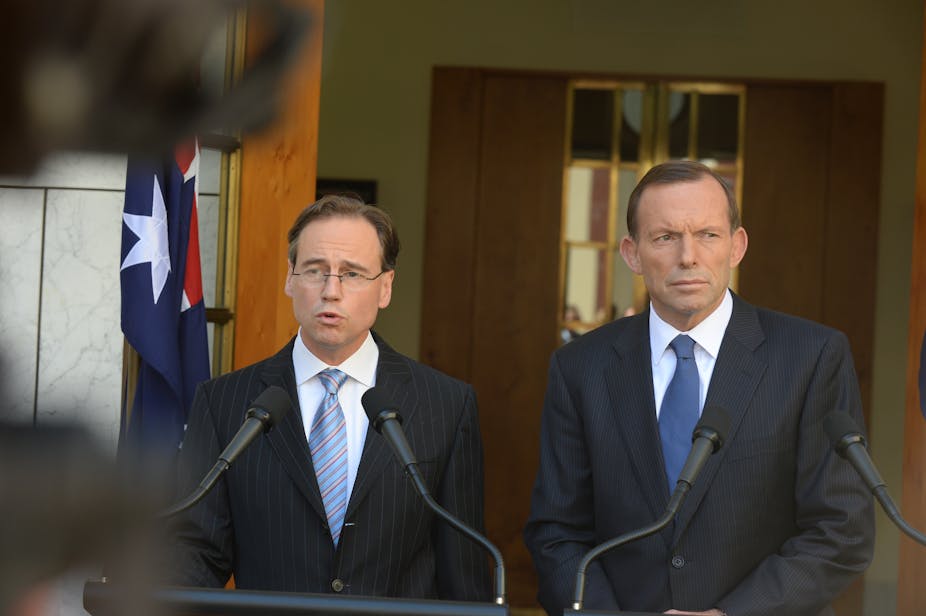This week Tony Abbott confirmed that Australia will not increase its emission reduction target from 5% below 2000 levels unless other countries make serious commitments.
In a subsequent interview, environment minister Greg Hunt expanded on the government’s position, stating that Australia will only review its commitments in 2015, and only then if there is genuine, comparable and binding commitments by other countries. He emphasised that “binding” was the critical criterion.
But this new position is at odds with established climate action and scientific recommendations, and will see Australia fall behind international action.
Australia’s international climate commitments prior to the election
Australia’s conditions for moving beyond the minimum 5% have been made clear in several international instruments which act as international law. Government officials have also made many ministerial statements.
Australia’s conditions for moving beyond 5% are:
The level of global ambition becomes sufficiently clear, including both specific targets of advanced economies and the verifiable emissions reduction actions of China and India.
The credibility of those commitments and actions is established.
There is clarity on the assumptions for emissions accounting and access to markets.
And that’s just to move beyond 5%. There are different conditions for increasing the target to a specific reduction such as 15% or 25%.
Before the election this target range enjoyed bipartisan support. While in caretaker mode, the Coalition endorsed signing of the Majuro declaration at the Pacific Islands Forum, which included Australia’s commitment to a 5-25% reduction in emissions with agreed conditions.
How are the new conditions different?
The conditions this week are new and stricter than previously, particularly deferring a review of the target until 2015. This implies that Australia will have to wait until after international climate talks in Paris in 2015 to decide whether it will join any agreement, and if it will consider increasing its target.
This is further implied by the government’s emphasis of the word “binding”. There is some uncertainty around what “binding” means (such as whether the government will consider targets to be binding through domestic legislation or at the international level). Arguably many countries have already made binding international legal commitments through the Cancun Agreements and other instruments, but a strict interpretation gives the government scope to require all countries to enter targets in a new treaty before Australia considers whether it should adopt the agreement or increase its target.
There is a critical timing issue in the government’s new conditions. By taking a “wait and see” approach, this will prevent Australia from being able to influence the shape and ambition of a new international agreement. This is likely to condemn Australia to being a climate laggard in the next two critical years of international negotiations.
Australia’s previous international commitments were not time-limited. Logically, they allowed Australia to increase its ambition at any time when the conditions were met.
Does this matter in practice?
The government’s new approach is likely to prevent Australia moving beyond 5% until after 2015.
This ignores recent advice from the Climate Change Authority that Australia’s conditions for moving beyond 5% have been satisfied. The authority argued that “a strong case can be made that the conditions for moving beyond 5% target have been met”.
Evidence supporting this includes since Australia set its target conditions, 99 countries, covering 80% of global emissions have pledged to reduce emissions before 2020. This includes many developing countries such as China and India.
By focusing on “binding targets”, this makes the level of international action that is taking place around the world largely irrelevant, as they must be formalised before Australia takes notice. But as we know, countries may set ambitious targets and then not meet them, such as Canada’s withdrawal from the Kyoto Protocol.
International action and emission reduction outcomes are arguably the most valuable indicators at an international level of whether Australia should increase its mitigation efforts. China’s implementation of emissions trading and the fact it is now the largest investor in renewable energy globally, and the US’ range of policies such as regulatory action limiting emissions from power stations, arguably represent more reliable evidence that countries are acting.
Implications beyond Australia
The next international climate agreement is hoped to be settled in Paris in 2015. This agreement is intended to set the world on a path to stabilising temperature rise to 2C.
Countries do not make decisions about climate targets in a vacuum. They will be influenced by the level of global action, and policies and targets of their neighbours, trading partners, and countries with similar economies.
Australia’s influence in international climate agreements should not be overstated. But we do play a pivotal role, by chairing key negotiating groups such as the Umbrella Group (which includes US, Russia and Japan) and the Cartegena Dialogue for Progressive Action. Australia’s inflexible “wait and see” stance is likely to have a detrimental effect on countries being willing to adopt or increase their targets. This will likely have serious consequences for the overall level of ambition of any global deal struck.
Australia’s target conditions are international legal commitments and Australia has represented its target range to the international community on several occasions. Changing the goal posts when arguably it looks like the conditions to move beyond 5% have been met, without any consultation or notice, is hardly a good look for Australia.
Overall, Australia is a wealthy country with a high capacity to act on climate change. Our strategic position in the Asia Pacific could enable us to influence our Asian neighbours to adopt clean energy policies. As the Climate Change Authority noted in its recent report, “drawing back from our international commitments will have a negative influence; an effect that is likely to be heightened due to Australia’s high level of development.”
Tony Abbott’s assertion that there is no evidence that countries are acting is perhaps most worrying of all, indicating that similarly to dismissing elements of climate change science, he is again simply ignoring clear evidence that other countries are acting.

